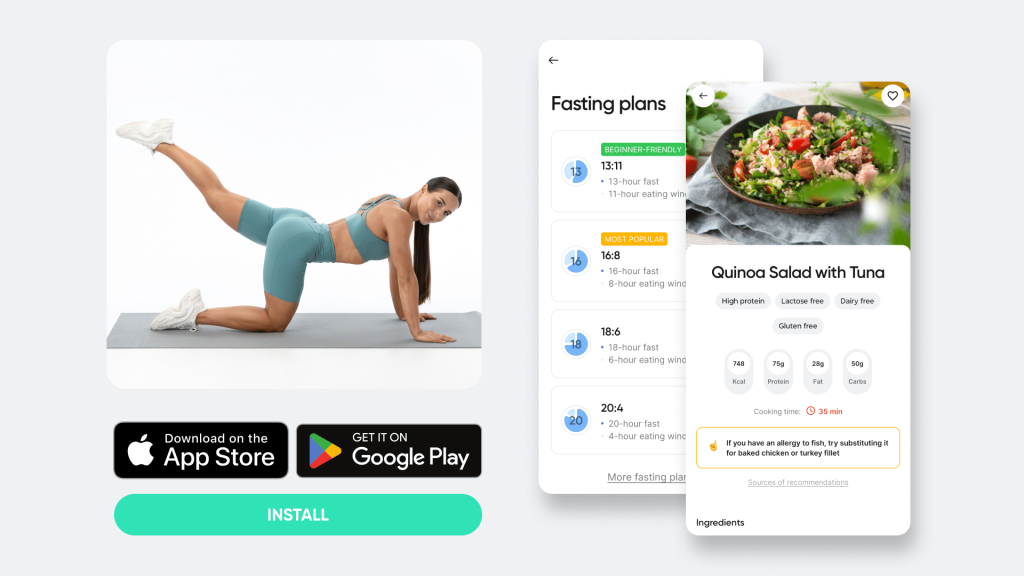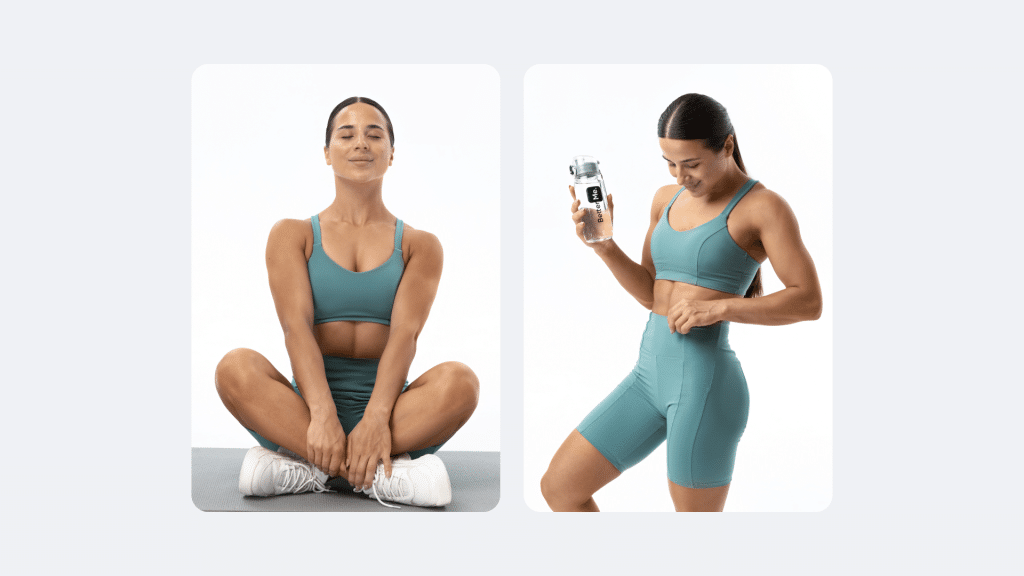If you’ve gotten caught up in the flurry of diet trends and health buzzwords, you’re not alone. It can be difficult to filter through all the noise and discover what truly works for you.
Yet, when done right, Intermittent Fasting (IF) can be a game-changer for your health and wellness goals. Research suggests that it may help with weight loss, improved metabolic health, and even longevity.
That said, today we’re giving you the simplest, most straightforward guide to IF in 2023 – answering all your burning questions with research-backed answers.
As you get started with IF, there are a few things to consider: the different types of fasts, potential health benefits and risks, and how to get into a rhythm that works for you. This guide will cover all these items and more so that you can confidently fast and reap the most benefits from it.
What Are The Basic Rules of Intermittent Fasting?
The golden rule of Intermittent Fasting is simple: Eat within your designated eating window and abstain from consuming calories during your fasting period. This rule reigns supreme because it’s the foundational principle that makes IF effective (4).
Sticking to this rule allows your body to cycle between periods of eating and fasting. During fasting periods, your body can focus on cellular repair processes and burning stored body fat, instead of digesting and metabolizing food (2).
Rule 1: Choose Your Fasting Pattern
There are several popular patterns of Intermittent Fasting, and it’s crucial to choose one that fits your lifestyle and health goals. The 16/8 method (16 hours of fasting and an 8-hour eating window) is a popular choice for beginners.
For instance, if you finish dinner by 8 pm, you would only need to skip breakfast and wait until noon the next day to eat again, keeping within a 16-hour fast.
When it comes to weight loss, progress is made by inches, not miles, so it’s much harder to track and a lot easier to give up. BetterMe app is your personal trainer, nutritionist and support system all in one. Start using our app to stay on track and hold yourself accountable!
Why Is 16 Hours The Magic Number for Fasting?
First, this fasting pattern aligns well with the human body’s natural circadian rhythm, making it more sustainable in the long run. Not sure what that means?
Your body’s circadian rhythm is essentially a 24-hour internal clock that runs in the background of your brain and cycles between sleepiness and alertness at regular intervals. It’s also known as your sleep/wake cycle (1).
During the day;
- Your body temperature is highest.
- You’re more alert and productive.
- Cortisol, the hormone that helps regulate metabolism, is released in higher amounts.
- You need more energy to support movement and activities..
At night:
- Your body temperature drops, which signals your sleep cycle to kick in
- You’re less alert and productive (energy demands are lower)
- Cortisol levels drop, indicating the body’s need to rest
The 16/8 method of fasting coincides neatly with this cycle, allowing most of your fasting hours to occur during sleep and inactive periods. This makes the fasting period feel more natural and less like a chore.
Second, fasting for 16 hours is thought to give your body enough time to enter a state of ketosis, a metabolic state where your body uses fat, instead of glucose, as its primary source of energy (7) This state may be a key player in weight loss and improved metabolic health – two major benefits touted by IF enthusiasts.
In essence, the 16/8 method is a good starting point because it’s simple, aligns with our natural rhythms, and provides enough fasting hours for your body to begin utilizing stored fat for fuel.
However, what works best for one person might not work as well for another. We’ll cover some other fasting patterns you may want to consider later in this guide.
Is It Better to Fast for 12 or 16 Hours, or More?
It is better to start with a shorter fasting window of 12-16 hours and gradually increase the duration as you become more comfortable with the process. Choosing the best types of fasting duration really depends on what is most convenient and easiest for you to maintain.
Below is a comprehensive list of all the fasting periods you can choose from:
12/12: A 12-hour fasting period and 12-hour eating window. No late-night snacking, and an early dinner is ideal.
14/10: A 14-hour fasting period with a 10-hour eating window. This one enables you to fast until midmorning or lunchtime, which can be helpful if breakfast is tough for you to give up.
16/8 Method (Leangains protocol): This method involves fasting every day for 14-16 hours and restricting your daily eating window to 8-10 hours.
20/4: Also known as the Warrior Diet, this involves fasting for 20 hours and eating all of your meals within a 4-hour window.
OMAD (One Meal A Day): Fasting for 23 hours and eating one meal within a 1-hour window
Eat-Stop-Eat: This involves fasting for 24 hours, once or twice a week. For example, not eating from dinner one day until dinner the next day.
5:2 Diet: With this method, you consume only 500-600 calories on two non-consecutive days of the week, but eat normally on the other five days.
Alternative Day Fasting: This method involves fasting every other day. Some versions allow about 500 calories on fasting days.
Warrior Diet: This involves eating small amounts of raw fruits and vegetables during the day and eating one big meal at night. Basically, you fast during the day and have a 4-hour eating window at night.
Spontaneous Meal Skipping: Skip meals when convenient. This is more of a non-structured fasting approach.
Each of these methods could be effective, but figuring out which one works best for you may require some experimentation.
Read more: Intermittent Fasting For Women Over 50.
Rule 2: Hydrate, Hydrate, Hydrate!
Drinking plenty of water is not only allowed during your fasting window, it’s encouraged.
Staying hydrated during your fasting period is not just suggested, it’s essential, and science backs it up.
Water is the backbone of life – it aids in digestion, nutrient absorption, and body temperature regulation. Even more, it helps your liver and kidneys function properly, filtering out waste products and toxins from your body (3).
During fasting, your body still carries out these processes and, as such, needs water to do this efficiently. Additionally, the body’s metabolic processes produce waste, which are flushed out with water.
Dehydration, on the other hand, can lead to headaches, fatigue, or a lack of concentration – things you definitely don’t want during your fasting period.
As a further note, drinking water can also help curb hunger pangs during your fast. Experts suggest that the sensation of thirst is sometimes mistaken for hunger. This means that staying well-hydrated will help you avoid unnecessary snacking and keep you on track with your fasting schedule (9).
Remember that while fasting it’s not only plain water that you can drink. Any zero- or very low-calorie beverages like sugarless black coffee, unsweetened green tea, and even sparkling water will also contribute to your hydration.
These will also give some variety to your fluid intake, making it easier to maintain your hydration levels.
Rule 3: Quality Over Quantity
While Intermittent Fasting doesn’t specifically dictate what foods to eat, it’s important to maintain a focus on nutritious, balanced meals during your eating window. Filling up on ultra processed, high-sugar snacks will leave you feeling sluggish and may hinder your weight loss and health goals.
The best intermittent fasting for weight loss will still involve some form of calorie restriction, so it’s important to monitor your caloric intake when following an IF plan.
Eating nutrient-dense foods (think: low-calorie, high-fiber foods like vegetables and fruits) will help you feel more satisfied with fewer calories, while still providing the energy and nutrients your body needs (5).
Even if you do indulge in a sugary snack, just make sure it fits into your overall caloric intake goals for the day. In other words, practice moderation.
Rule 4: Listen to Your Body
Adapting to Intermittent Fasting can take some time, and it’s crucial to listen to your body’s signals. If you’re feeling overly fatigued or unwell, it might be time to revisit your fasting schedule or what you’re eating during your feeding window.
Intermittent fasting for beginners may be quite challenging in this regard; but knowing which symptoms are normal and which ones are signs that you need to take a step back, will help you find the intermittent fasting schedule that works best for your body.
Some side effects to expect include:
- Headaches
- Low energy levels
- Hunger pangs
- Cravings
- Irritability
- Bad breath
- Constipation or digestive issues
If you experience any of the above, don’t panic. This is normal and usually a sign that your body is adapting to its new routine.
Make sure to get enough sleep, drink plenty of water, and eat nutritious foods during your feeding window; these things should help ease these symptoms. If they persist, however, consider adjusting your schedule.
Some signs that are not normal and may warrant a break from intermittent fasting include:
- feeling overly fatigued
- feeling dizzy or lightheaded
- having a racing heart
- feeling faint
These are signs that your body may not be tolerating the fasting schedule well. Talk to your healthcare provider about any concerns you have.
How Should a Beginner Start Intermittent Fasting?
As a beginner who is starting intermittent fasting, proceed gradually, systematically, objectively, with the right information, and include some activity for added health benefits. Note that you should start your fasting in a manner that’s:
Gradual
Begin with a gentle approach. Adopt the 16/8 intermittent fasting schedule, where you fast for 16 hours and eat within an 8-hour window. You can even start with 12/12 and work your way up to 16/8. This schedule is quite manageable as it essentially involves skipping breakfast and avoiding late-night snacking.
Systematic
Implement a well-designed intermittent fasting diet plan. Make sure the plan is balanced and provides all the necessary nutrients your body needs. You can find a free intermittent fasting plan online that suits your lifestyle and dietary preferences.
Objective
Identify your goals. If weight loss is your primary aim, consider which method is the best intermittent fasting for weight loss for you. Whichever method results in you eating fewer calories than you burn overall is likely to produce weight loss, and the one that fits best into your lifestyle and schedule is the one you will be able to stick to long enough to see meaningful results..
Informed
Understand the intermittent fasting benefits, which range from weight loss and improved metabolic health to increased longevity. This knowledge will help you stay motivated and committed to your new eating pattern.
Active
Incorporate intermittent fasting exercise into your routine. Exercise and intermittent fasting can go hand in hand. Schedule your workouts around your eating windows to ensure you have enough energy and nutrients for recovery.
BetterMe app is a foolproof way to go from zero to a weight loss hero in a safe and sustainable way! What are you waiting for? Start transforming your body now!
How Long Does It Take for 16:8 Intermittent Fasting to Work?
The timeline for experiencing benefits from the 16:8 intermittent fasting method can vary from person to person, largely depending on individual body composition, lifestyle, and goals. However, research has provided some general timelines for when you might start to see specific results:
4-6 Weekcs for Weight Loss
If weight loss is your primary objective, you might start observing noticeable differences on the scale within 4 to 6 weeks of starting a 16:8 Intermittent Fasting regimen.
However, the exact timeline can vary based on your starting weight and how effectively you stick to your eating window and food choices. It’s important to remember that consistent, healthy eating habits are key to sustainable weight loss.
8-12 Weeks for Improved Blood Sugar Control
Intermittent fasting can lead to improved blood sugar control, a significant factor if you’re at risk or have type 2 diabetes (8).
Some studies have observed these benefits within 8 to 12 weeks. The fasting period may prompt the body to regulate insulin better, leading to more balanced blood sugar levels.
However, it’s crucial to be sure that you’re consuming nutrient-dense, low-sugar foods during your eating window. If you’re diabetic, it’s also important to consult with your doctor before starting an Intermittent Fasting regimen.
6-12 Weeks for Enhanced Heart Health
Intermittent fasting has been linked to a range of heart health benefits, from lowering blood pressure to improving cholesterol levels (6). Some studies have observed these benefits after 6-12 weeks..
This period allows your body to adjust to the new eating pattern, possibly leading to more efficient fat burning and lowered inflammation, which contribute to improved cardiovascular health.
However, these changes may not be outwardly noticeable and often require medical testing to confirm.
12 Months for Longevity Benefits
The potential longevity benefits of intermittent fasting, such as reduced risk of chronic diseases and extended lifespan, are long-term goals and may require consistent practice over an extended period (8).
Some of these benefits are difficult to measure and may take up to a year or more to observe, although we can’t say for sure because there isn’t enough long-term data. These same benefits are not only from IF; other healthy lifestyles can bring about the same results.
Read more: What Can You Drink During Intermittent Fasting?
Frequently Asked Questions
Why Am I Not Losing Weight on 16/8 Fasting?
If you’re not losing weight as expected on 16/8 fasting, you may be underestimating just how much you’re eating during your eating window. Perhaps you’re accidentally breaking your fast by drinking coffee with milk, having a bite of something or drinking sugary beverages during your fasting window. Or maybe you’re simply eating too many calories during your eating window.
Bear in mind that 16/8 is not a one-size-fits-all solution for weight loss and other lifestyle changes may be necessary as well. Exercise, adequate sleep, and stress management are all key components of any successful weight loss journey.
Do You Have a Cheat Day on Intermittent Fasting?
Cheat days are not typically part of the intermittent fasting routine. However, flexibility is key to sustaining any long-term dietary change.
If an occasional day off helps you stick to your fasting schedule long-term, it may be worth considering. Remember, the overall pattern of dietary choices matters more than single day indulgences.
Does Sleeping Count as Fasting?
Yes, sleeping does count as fasting. Most intermittent fasting plans involve fasting through the night, which naturally includes sleep hours.
For example, in the 16/8 method, you might eat your last meal at 8 p.m. and then fast until noon the next day, including your sleep hours in the fasting period.
What is a Good Breakfast for Intermittent Fasting?
The first meal after an intermittent fast should be rich in nutrients and relatively easy to digest. Options might include protein-rich foods like eggs or Greek yogurt, complex carbohydrates such as whole grains or quinoa, and plenty of fruits or vegetables. The goal is to replenish your body with the nutrients it needs after a prolonged fast.
Can I Fast from 8pm to 12pm?
Yes, you can fast from 8pm to 12pm. This would be a 16-hour fast, fitting within the parameters of the popular 16/8 method of intermittent fasting.
During this fast, you would abstain from eating and only consume non-caloric beverages like water, black coffee, or tea. Then, you would have an 8-hour eating window from 12pm to 8pm.
The Bottom Line
Intermittent fasting is a popular eating pattern that might lead to a range of health benefits, from weight loss and improved metabolic health to increased longevity.
For beginners, the intermittent fasting diet plan 16/8 method is an excellent starting point, as it’s easy to stick to and requires minimal lifestyle adjustments.
To see the full effects of intermittent fasting on your body, it’s best to be consistent and patient with the practice over a period of time. When done right, this timeless eating pattern can prove beneficial for almost anyone.
DISCLAIMER:
This article is intended for general informational purposes only and does not serve to address individual circumstances. It is not a substitute for professional advice or help and should not be relied on for making any kind of decision-making. Any action taken as a direct or indirect result of the information in this article is entirely at your own risk and is your sole responsibility.
BetterMe, its content staff, and its medical advisors accept no responsibility for inaccuracies, errors, misstatements, inconsistencies, or omissions and specifically disclaim any liability, loss or risk, personal, professional or otherwise, which may be incurred as a consequence, directly or indirectly, of the use and/or application of any content.
You should always seek the advice of your physician or other qualified health provider with any questions you may have regarding a medical condition or your specific situation. Never disregard professional medical advice or delay seeking it because of BetterMe content. If you suspect or think you may have a medical emergency, call your doctor.
SOURCES:
- Circadian Rhythms (2023,nih.gov)
- Fasting: Molecular Mechanisms and Clinical Applications (2015,nih.gov)
- Focus on wellness: Staying hydrated (2017,jhu.edu)
- Intermittent fasting: the science of going without (2013,nih.gov)
- Increased Intake of Foods with High Nutrient Density Can Help to Break the Intergenerational Cycle of Malnutrition and Obesity (2015,nih.gov)
- Intermittent Fasting: A Heart Healthy Dietary Pattern? (2020,nih.gov)
- What Happens to Your Body When You Fast for 16 Hours? (2021,medicinenet.com)
- What is intermittent fasting? Does it have health benefits? (2022,mayoclinic.org)
- Yes, drinking more water may help you lose weight (2020,hu.edu)










